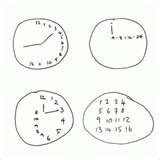Alzheimer's Clock Draw Test -- Detect the Signs of Alzheimer's Early
Drawing a clock by hand is one of several useful screening tools that can help to detect dementia, or Alzheimer's.
Editor Note: If you are looking for additional self assessment tests for Alzheimer's visit the following page --
They say that doctors often use the clock draw test.
This test can help you, or your doctor, differentiate between normal aging and possible dementia.
If you administer the test on your own and find the results either disconcerting or suspicious, schedule an appointment with your personal care physician. Take the copy of the clock test with you to the doctor appointment, and show the test to the doctor.
Insist on a referral to a memory specialist for testing.
Also, please review this article --
-- and take it with you to the doctor appointment for the purpose of discussion.
There are many diseases that can present as dementia or Alzheimer's. Getting the correct diagnosis is difficult under any and all circumstances. You need to be sure all the proper tests are administered.
By Bob DeMarco
Alzheimer's Reading Room
The Clock Drawing Test
Have the person draw a clock by hand on a large piece of paper.
Have the person draw the face of a clock and put the numbers in the correct positions.
Then have them draw the hands to indicate 3:40 (time).
Clock Drawing Test Scoring
To score, assign the following points for each part of the drawing:
- 1 point for a closed circle
- 1 point for properly placed numbers
- 1 point for including all twelve numbers
- 1 point for properly placed hands

Conclusions
The clock-drawing test meets defined criteria for a cognitive screening instrument. It taps into a wide range of cognitive abilities including executive functions, is quick and easy to administer and score with excellent acceptability by subjects. Together with informant reports, the clock-drawing test is complementary to the widely used and validated Mini-Mental State Examination and should provide a significant advance in the early detection of dementia and in monitoring cognitive change. A simple scoring system with emphasis on the qualitative aspects of clock-drawing should maximize its utility.
Source http://www.ncbi.nlm.nih.gov/pubmed/10861923
Original content the Alzheimer's Reading Room







0 comments:
Post a Comment